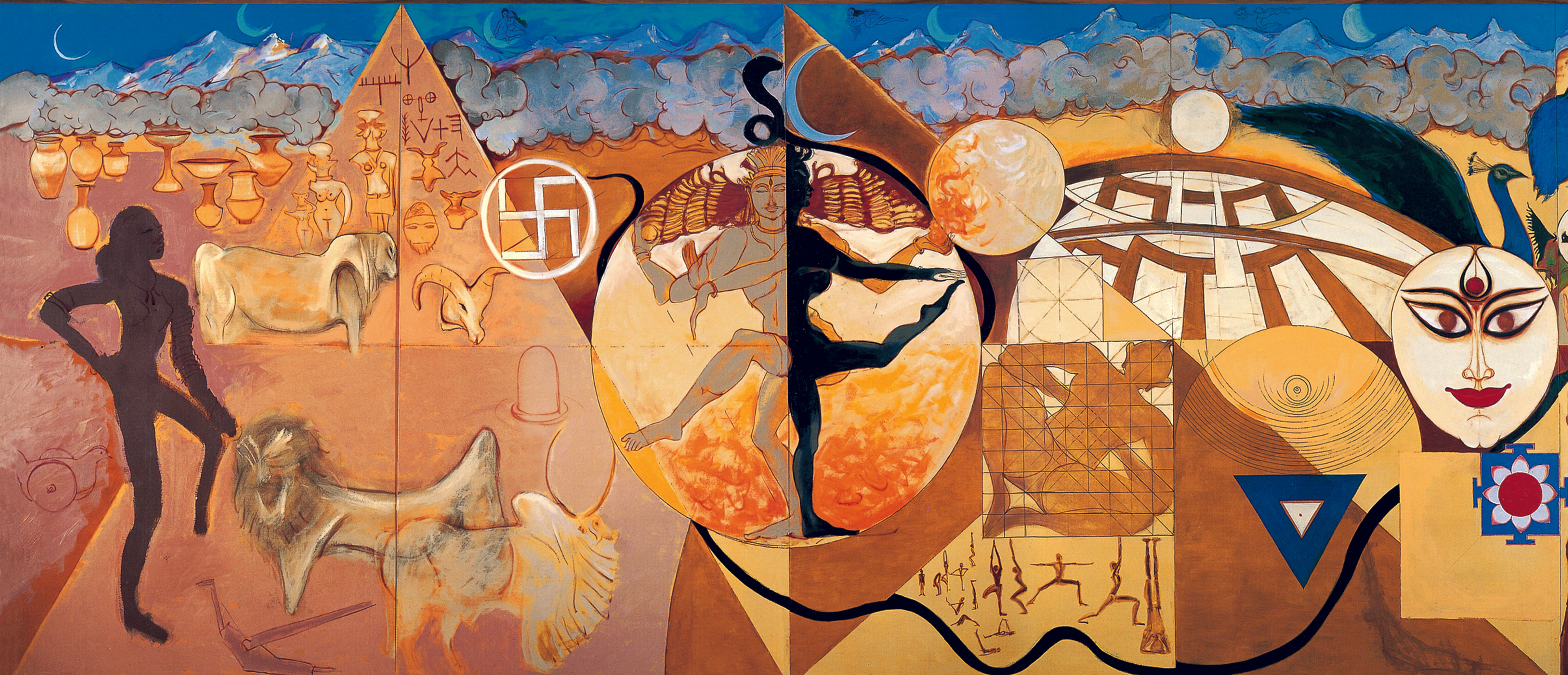
Das' mural at the old Parliament building in New Delhi.
(Pic courtesy: NGMA, New Delhi)
Most great artists, across geographies, have stuck to a medium or at the most two, in which their mastery has been celebrated. For 1941-born Jatin Das, the medium has always seemed almost like a backdrop. His six decades of outpouring of creativity have seen him traverse mediums and forms of artistic expression. Graphics, drawings, oils, sculptures, murals, charcoal, tiles, platters and even manhole covers — the range is unparalleled.
As he says, “I like playing with different mediums. I am a painter, wanting to be an artist. But painting is also drawing. Drawing is also sculpting. It is a matter of creating negative and positive spaces. The ecstasy and the poetry of a line transcend tone and colour. Each medium can be rewarding or limiting, depending on how you handle it. I pursue my instinct, my passion, and my concerns.”
Is this a sign of creativity meshed with a certain restlessness? “It all depends on what my inner mind says at the moment, or what is available, then I use that particular medium,” elaborates Das. “There is no real hierarchy in it. There are times when the medium inspires the work. I draw with conté and ink, and paint with oil, watercolour and ink.”
Das’ retrospective, the largest ever collection of his diverse works — about 400, was on view at the National Gallery of Modern Arts (NGMA), Delhi. Curated by his two elder children, daughter Nandita Das, actor, producer, and director and her brother Siddartha Das, an architect, who works with textiles, it consisted of an exhibition and a book that showcases about six decades of his works.
“A retrospective show is an artist’s lifetime’s work,” Das muses. “There is never enough time to go through one’s lifetime’s work. I began to take out old works that I had not seen for half a century! I was surprised to see how the figuration in my works has changed and evolved.” He credits his children for this ambitious endeavour. “The artist knows his works the best and can curate them but some distance is also needed.”
Perhaps age has a say in an artist, who, as part of the Bombay Progressives Group, once believed in a pace that could only be termed extraordinary. “I find painting fun but preparing for an exhibition is boring and exhausting,” he says. “You have to take out the works, photograph, mount, frame, and document them. Being an artist, you have to hold shows and sell your work, simply to live. That’s the dichotomy — I live on the sale of my paintings, but I do not paint to sell. To put out such a large body of work together was not easy.”
The curators admit the challenge. “To sieve through 60 years of the work and life of a prolific painter and a maverick misfit has been an enormous challenge and privilege,” says his daughter. “Siddhartha and I, for many months, made the selection. The first round had almost 1,500 works, many of which we had never seen or had become blurry in our minds. It was like mining gems from the nooks and corners of his studio! We wanted to make sure we had work from every era and every medium. ”
She distils his art as perhaps only someone who has closely seen him over decades can do. “Even as his children, we are awed by the large and varied body of work he has created in the last 60 years. His restless energy, spirit, loneliness, pain, search, wonderment — they all find a creative expression. Central are his human figures —iconic and primal — with a life of their own. His spirit is that of a seeker, an observer, who ferrets out the essence of people, places and objects and pours them all out in his art. Though he is a figurative artist, he also draws and paints with equal ease — birds, animals, people, places… whatever catches his inner eye. He embraces every medium with a flourish and with no fear of the unknown.”
He still stands out, especially in relation to today’s art scenario. He notes a tremendous change though. “People talk about the art market and art business, and those who come to see your works are called clients! I have successfully insulated myself from the commodification of my work. The so-called modern education system has created many divisions and has limited the imagination of a child. So, various forms of art are disjointed and completely divorced from life.”
His advice is straightforward. “To find your true self in art, one has to unlearn everything. Then do what your inner mind tells you. Sadly, we are taught to focus on the goal. But what is more important is the journey. I urge young people to experience and explore their surroundings first. Learn from nature and folk and traditional arts, which are the most important influences for an artist.”